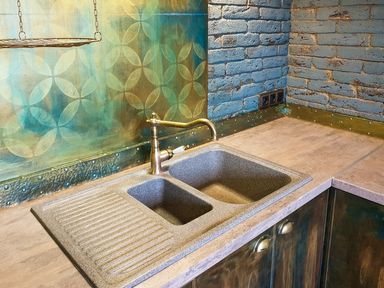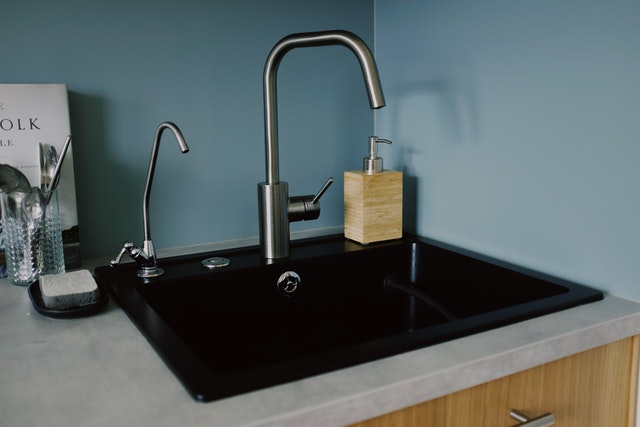We all love our bathrooms. They’re a place to relax, unwind, and take care of ourselves. We love to splash out on sinks and baths, but sometimes we give less thought to the basin material. Whether you’re looking for a new basin or replacing an old one, there are many different materials that can be used for your bathroom vanity unit. Here we compare and contrast two popular choices—solid surface vs engineered stone. But before going into their differences, let’s first dive into what each basin is exactly.
- What Is a Solid Surface Basin?
- What Is the Best Solid Surface Basin?
- What Is an Engineered Stone Basin?
- What Is the Best Engineered Stone Basin?
- Solid Surface vs Engineered Stone Basins: Differences Between Each

What Is a Solid Surface Basin?
A solid surface basin is a type of sink that is made from a single piece of man-made material. These sinks often resemble natural stone, but they are actually made out of acrylics or polyester-based plastics. Solid surface basins are extremely durable and resilient against impact, so they are ideal for use in commercial environments where they will be exposed to wear and tear. Solid surface basins are also available in a range of different colors and finishes, so you can pick one that matches your bathroom’s decor.
What Is the Best Solid Surface Basin?
The best solid surface basin is the one that fits your needs and style, but there are a few factors you should consider when shopping for one. The most important thing is the solid surface material of the basin itself: if you want something that’s going to last, then choose a solid surface from some reputable solid surface countertop brands that offer acrylic or polyester. You should also think about how much space you have available in your bathroom and whether or not it has a window positioned above it.
Solid Surface Pros:
1. Highly durable and impact resistant.
Because they are made from such strong and flexible materials, solid surface basins can withstand hard knocks.
2. Versatile design.
Solid surface basin designs are extremely versatile, and you can find a range of different shapes and colors.
3. Easily repairable with fillers.
Fillers can be used to repair any surface scratches and light damage, allowing damaged sections to be removed and replaced with new and undamaged parts that blend.
4. Easy to clean.
Solid surface basins are easy to care for and clean because they don’t trap dirt like porous materials; this means you have less maintenance work.
Solid Surface Cons:
1. Soft surface.
A solid surface may be sturdy and resistant to impact, but it is also vulnerable to being scratched or gouged by sharp objects.
2. Expensive.
Solid surface basins tend to be more expensive than other types of basin material.
3. Poor physical appeal.
Many consider solid surface basins to be unattractive in appearance, especially when compared with basins made of other materials.
What Is an Engineered Stone Basin?
The term engineered stone can be confusing, as it is not a single material. Instead, engineered stone is a composite material made of natural stone and resin. The most common type of engineered stone is composed mainly of quartz crystals, which are then mixed with resins to create the desired color.
This type of stone is strong, durable, and resists stains. The resins also make it possible to create basins with a wide range of colors, patterns, and textures. It’s important to note that engineered stone is not as hard as natural quartzite or granite; however, it’s more resistant to scratches than other types of materials.
What Is the Best Engineered Stone Basin?
The best engineered stone sink for you is the one that will meet your needs and provide value over time. If you’re looking for a high-quality, durable basin, then you’ll probably want to look into granite or marble. But if you’re just looking for something that’s affordable, then quartz or limestone might be the way to go.
Engineered Stone Basin Pros:
1. Sturdy and durable.
Engineered stone basins are finished to a high quality and boast exceptional durability, making them almost as tough as granite.
2. Heat and scratch resistant.
Engineered stone is resistant to scratches and high temperatures, making it a good material for kitchens.
3. Easy to clean.
Engineered stone basins are typically easier to keep clean because their smooth surfaces don’t harbor bacteria or trap dirt like other materials.
Engineered Stone Basin Cons:
1. Degrades outdoors.
Because it discolors when exposed to sunlight, engineered stone is not well-suited for outdoor use.
2. Difficult to shape.
Engineered stone is difficult to shape and create round or curved edges. The edges are not always smooth; as a result, the design options can be limited.
Solid Surface vs Engineered Stone Basins: Differences Between Each
The primary difference between engineered stone and solid surface materials is how they’re made. A solid surface is created by mixing chemicals with resins and water, which are then poured into molds. The material sets up as it cures. Engineered stone is made by fusing together layers of natural stone, quartz, or marble that have been ground to a certain thickness. Here are a few notable differences between solid surface vs quartz or engineered stone basins.
Material Composition
Solid surfaces are made with a variety of different materials. They can be composed of resins and pigments, or they can be used in conjunction with natural stone. Engineered stone is made primarily from quartz or marble.
Appearance
Both solid surfaces and engineered stone basins are available in a variety of colors and finishes. Engineered stone and surface stone basins can look very different or like twins depending on the coloration or tone. Engineered stone countertops are often highly polished, while solid surface countertops have more of a matte finish.
Solid Surface vs Quarts Price
In terms of price, engineered stone is generally more expensive than solid surfaces. A solid surface is a cheaper alternative to engineered stone, but it still comes with a hefty price tag.
While there are many reasons for the difference in price between quartz and solid surface basins, one factor is definitely labor. Quartz tends to take more time and effort on the part of installers than does solid surface—but this may or may not be a factor depending on the design and installation process.

Conclusion
The two products, solid surface and engineered stone basin, have their own interests. Each of them has its own advantages, not only based on preferences but also on a variety of factors to be considered. Both products are widely used in various fields and industries, so if you want to buy one for your bathroom or kitchen, you need to make sure that the product you choose will meet your needs and requirements.
FAQ about Solid Surface vs Engineered Stone
A solid surface can last for many years if it’s properly cared for. While it’s impossible to say exactly how long a countertop will last for any individual, most of them will have a lifespan of at least twelve years, which is a telling detail. It all depends on how each individual owner manages the product throughout their daily routine. After that it could be recycled or disposed of safely as solid surfaces can also be recycled fairly easily.
Laminate countertops are one of the most common household items adorned in kitchens and bathrooms. That’s because it’s considered to be fairly low-maintenance and easily attached to existing counters, even marble, and because of its water and stain resistance. Cleaning up these countertops is easy, and for a busy family, even easier when kids are about, too.
Granite countertops are perhaps the most durable you will find on the market and the best for kitchens with plenty of use, as granite’s high compressive strength can withstand heavy wear and tear.
0 Comments for “Solid Surface vs Engineered Stone Basin: A Detailed Comparison”